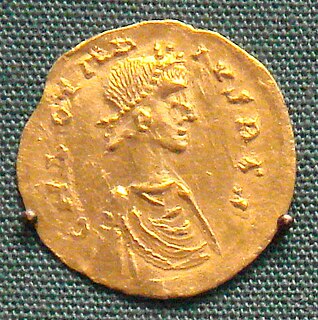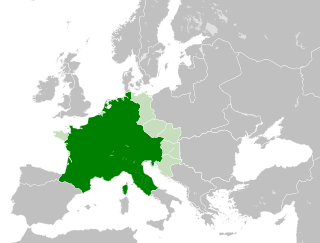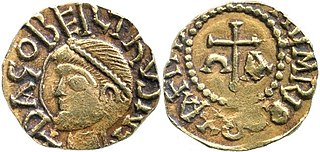
Year 656 (DCLVI) was a leap year starting on Friday of the Julian calendar. The denomination 656 for this year has been used since the early medieval period, when the Anno Domini calendar era became the prevalent method in Europe for naming years.

Pepin Iof Landen, also called the Elder or the Old, was the Mayor of the Palace of Austrasia under the Merovingian king Dagobert I from 623 to 629. He was also the mayor for Sigebert III from 639 until his death.

Chlothar II, called the Great or the Young, was King of Neustria and King of the Franks, and the son of Chilperic I and his third wife, Fredegund. He started his reign as an infant under the regency of his mother, who was in an uneasy alliance with Clothar's uncle Guntram, King of Burgundy. Clothar assumed full power over Neustria upon the death of his mother, in 597; though rich this was one of the smallest portions of Francia. He continued his mother's feud with Queen Brunhilda of Austrasia with equal viciousness and bloodshed, finally achieving her execution in an especially brutal manner in 613, after winning the battle that enabled Chlothar to unite Francia under his rule. Like his father, he built up his territories by moving in after the deaths of other kings.

Neustria, or Neustrasia, was the western part of the Kingdom of the Franks.
Under the Merovingian dynasty, the mayor of the palace or majordomo was the manager of the household of the Frankish king. The office existed from the sixth century, and during the seventh it evolved into the "power behind the throne" in the northeastern kingdom of Austrasia. In 751, the mayor of the palace, Pepin the Short, orchestrated the deposition of the king, Childeric III, and was crowned in his place.

Francia, also called the Kingdom of the Franks, or Frankish Empire, was the largest post-Roman barbarian kingdom in Western Europe. It was ruled by the Franks during Late Antiquity and the Early Middle Ages. It is the predecessor of the modern states of France and Germany. After the Treaty of Verdun in 843, West Francia became the predecessor of France, and East Francia became that of Germany. Francia was among the last surviving Germanic kingdoms from the Migration Period era before its partition in 843.

Dagobert II was the Merovingian king of the Franks ruling in Austrasia from 675 or 676 until his death. He is one of the more obscure Merovingians. He has been considered a martyr since at least the ninth century.

Childebert III the Adopted was a Frankish king.

Charibert II, a son of Clotaire II and his junior wife Sichilde, was briefly King of Aquitaine from 629 to his death, with his capital at Toulouse. We have no direct statement about when Charibert was born exactly, only that he was "a few years younger" than his half-brother Dagobert. His father Clotaire evidently had a bigamous marriage and he was the offspring of the junior wife.

The Agilolfings were a noble family that ruled the Duchy of Bavaria on behalf of their Merovingian suzerains from about 550 until 788. A cadet branch of the Agilolfings also ruled the Kingdom of the Lombards intermittently from 616 to 712. They are mentioned as the leading dynasty in the Lex Baiuvariorum. Their Bavarian residence was at Regensburg.
Grimoald I (616–657), called the Elder, was the Mayor of the Palace of Austrasia from 640 to 656. He was the son of Pepin of Landen and Itta.
Bilichild was the wife of the Frankish king of Neustria and Burgundy Childeric II. The two were married in 668 despite the opposition of the Bishop Leodegar.
Adalgisel or Adalgis was a Frankish duke and the mayor of the palace of Austrasia. He assumed that office in December 633 or January 634 at the same time that Sigebert III assumed the kingship. Along with Cunibert, Bishop of Cologne, he acted as regent for the young king. Adalgisel, Cunibert, and Sigebert were all appointed by Dagobert I.
Radulf was the Duke of Thuringia from 632 or 633 until his death after 642.
Leutharis, Leuthari, Leuthard, or Leutharius II was the Duke of Alamannia in the early seventh century.
Sigebert IV was the son of Dagobert II and a Saxon duchess called Mathildis, and the grandson of Sigebert III of the Merovingian dynasty. He is believed to have died either just before or after his father and other members of the royal family, who were killed on the orders of Ebroin, the Frankish Mayor of the Palace of Neustria.
The royal household of the early kings of the Franks is the subject of considerable discussion and remains controversial. This discussion is aimed at identifying the major categories of participants in the administration and those who made the major historical impacts. Every king of the Franks from Clovis I to Charles the Bald had a large cadre of advisors and bureaucrats that helped implement their regime. These supporters of the crown are frequently unknown, but often are ancestors of the later rulers of France. This is not intended to be a complete list of those supporting the kings but to serve as a guide for further study. A general discussion of the Merovingian and Carolingian dynasties can be found in the associated main articles. See also Government of the Carolingian Empire.
This page is based on this
Wikipedia article Text is available under the
CC BY-SA 4.0 license; additional terms may apply.
Images, videos and audio are available under their respective licenses.












